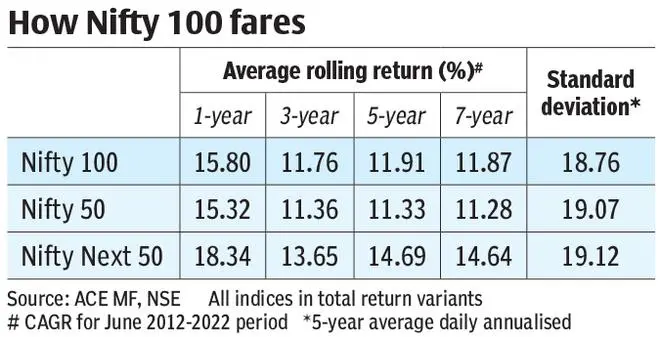With the stock market correcting by around 12 per cent this calendar year so far, long-term investors now have an opportunity to enter equities again. If you have a 3-5 year horizon and can take moderate risk, you can accumulate on dips the units of Nippon India ETF Nifty 100.
Compared to Nifty 50 and Nifty Next 50 indices, the Nifty 100 offers a more diversified substitute for investors looking at broader market exposure. Nippon India ETF Nifty 100 offers a simple, cost-effective and liquid way to gain from the stock price movement of the top 100 companies based on full market capitalisation from the Nifty 500 universe.
Nifty 100 index for 3 reasons
Investors looking at large-cap passive products can consider Nifty-100 based products today for three reasons.
One, compared to the Nifty 50's around 65 per cent and Nifty Next 50's 15 per cent representation of the free float market capitalisation of the stocks listed on the NSE, Nifty 100, at over 75 per cent representation, offers a much better broad-based index representation of the diversified equity market in India. The across-the-board corrections now provide the opportunity to take exposure to a wider set of stocks.
Two, while the Nifty Next 50 has outperformed broad-based Nifty 50 over one-, three-, five and seven-year periods consistently on a rolling return basis, it is more volatile in terms of standard deviation (see table). Nifty 100 can be a good way to get exposure to the Nifty Next 50 stocks, without the volatility.
Three, for those with a long-term perspective, equities are now a play on economic revival prospects. Historically, we have witnessed that economic revival triggers growth in large-cap and larger mid-cap stocks initially, later trickling to mid- and small-caps. Hence Nifty 100 offers a clean way to leverage market revival advantage.
Investors should however note that investing in the Nifty 100 is not the same as making a 50:50 investment in both Nifty 50 and Nifty Next 50 indices. The weights of Nifty 50 and the Nifty Next 50 companies in the Nifty 100 combined index are very different. Also, Nifty 100 is a market-cap weighted index, which means significantly-larger Nifty 50 companies get a higher total weight in the index. At the same time, Nifty 100 has generated 50-60 basis points higher returns than Nifty 50 over one-, three, five- and seven-year rolling return basis.

Why Nippon India ETF Nifty 100
While the Nifty 100 represents a good investment, index funds tracking this large-cap index have only recently been launched by AMCs such as Axis MF (2019), IDFC MF (2022) and HDFC MF (2022). On the other hand, plain-vanilla Nifty 100 ETFs provide entry and exit facility during market hours usually five days a week, cost half as much than index fund counterparts and also have longer track records.
Out of the three Nifty 100 ETFs, we prefer Nippon India ETF Nifty 100 on account of multiple advantages.
Nippon India ETF Nifty 100 (₹165 crore assets) has a tight premium/discount over NAV over the last three years, reasonable impact cost (0.33 per cent), decent three-year annualised tracking error (0.12 per cent based on daily return), economical expense ratio (0.5 per cent), good trading volumes and a over nine-year track record. This apart, Nippon Life India Asset Management is an experienced player in passive products (over two dozen ETFs across asset-classes) market where it manages an AUM of ₹55,800 crore and has a market share of 14 per cent. As of March 2022, Nippon India had 68 per cent share of ETF volumes on the NSE and BSE, while ETF average daily volume across key funds is higher than the rest of the industry.
Stagger purchases
The adverse macroeconomic backdrop with heightened worries on rising interest rates, elevated crude oil prices and liquidity tightening has kept the market jittery. But the domestic earnings season continues to remain healthy and provides a silver lining, notwithstanding the challenges faced on multiple fronts.
After correction, domestic stock market trades near its long-term average valuations. If earnings delivery happens without major hiccups, markets will hold their forte and may see a swifter recovery.
Thus, investors should ideally stagger their purchases and accumulate Nippon India ETF Nifty 100 units on dips, instead of doing a one-time lump-sum investment.









Comments
Comments have to be in English, and in full sentences. They cannot be abusive or personal. Please abide by our community guidelines for posting your comments.
We have migrated to a new commenting platform. If you are already a registered user of TheHindu Businessline and logged in, you may continue to engage with our articles. If you do not have an account please register and login to post comments. Users can access their older comments by logging into their accounts on Vuukle.